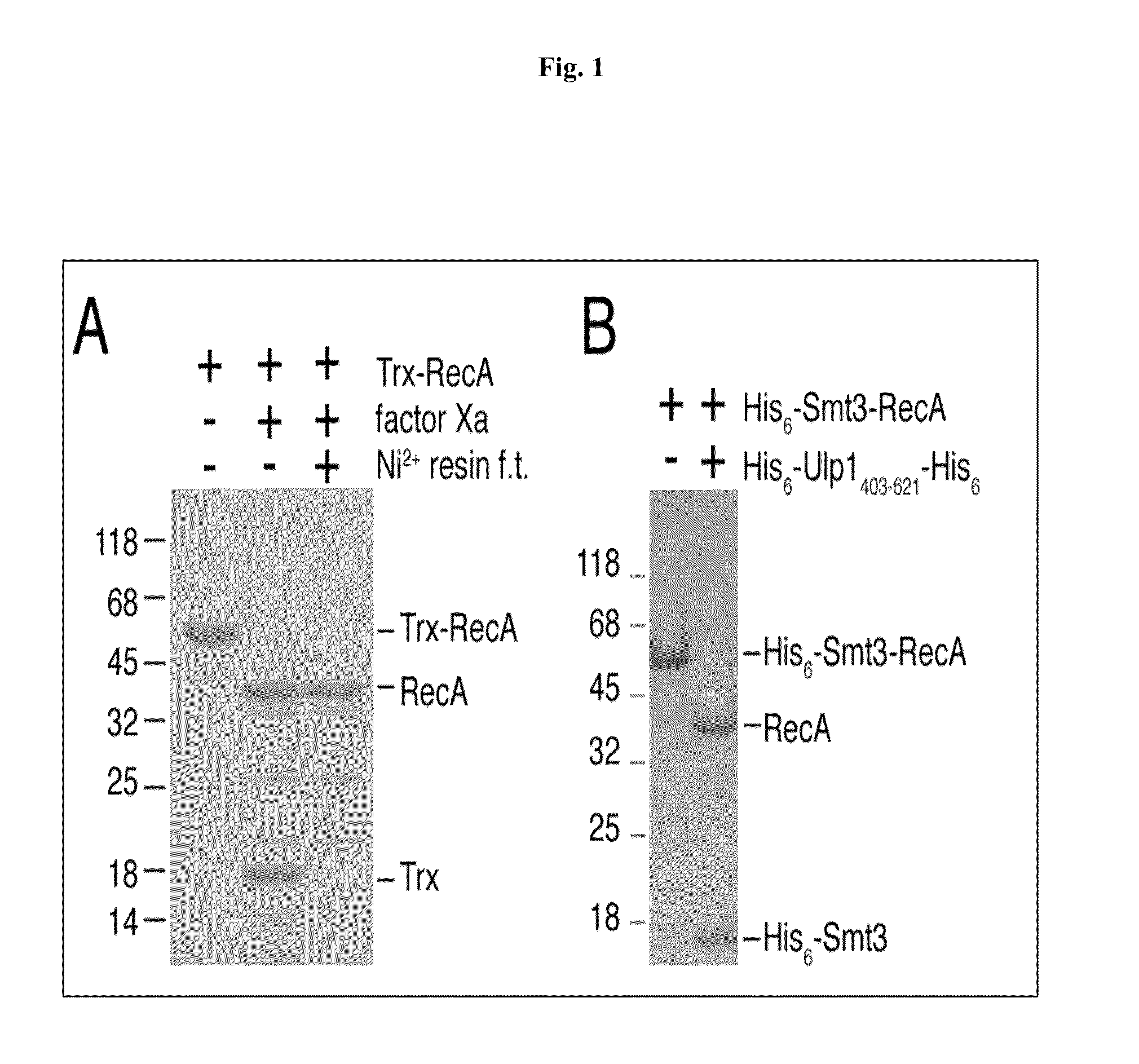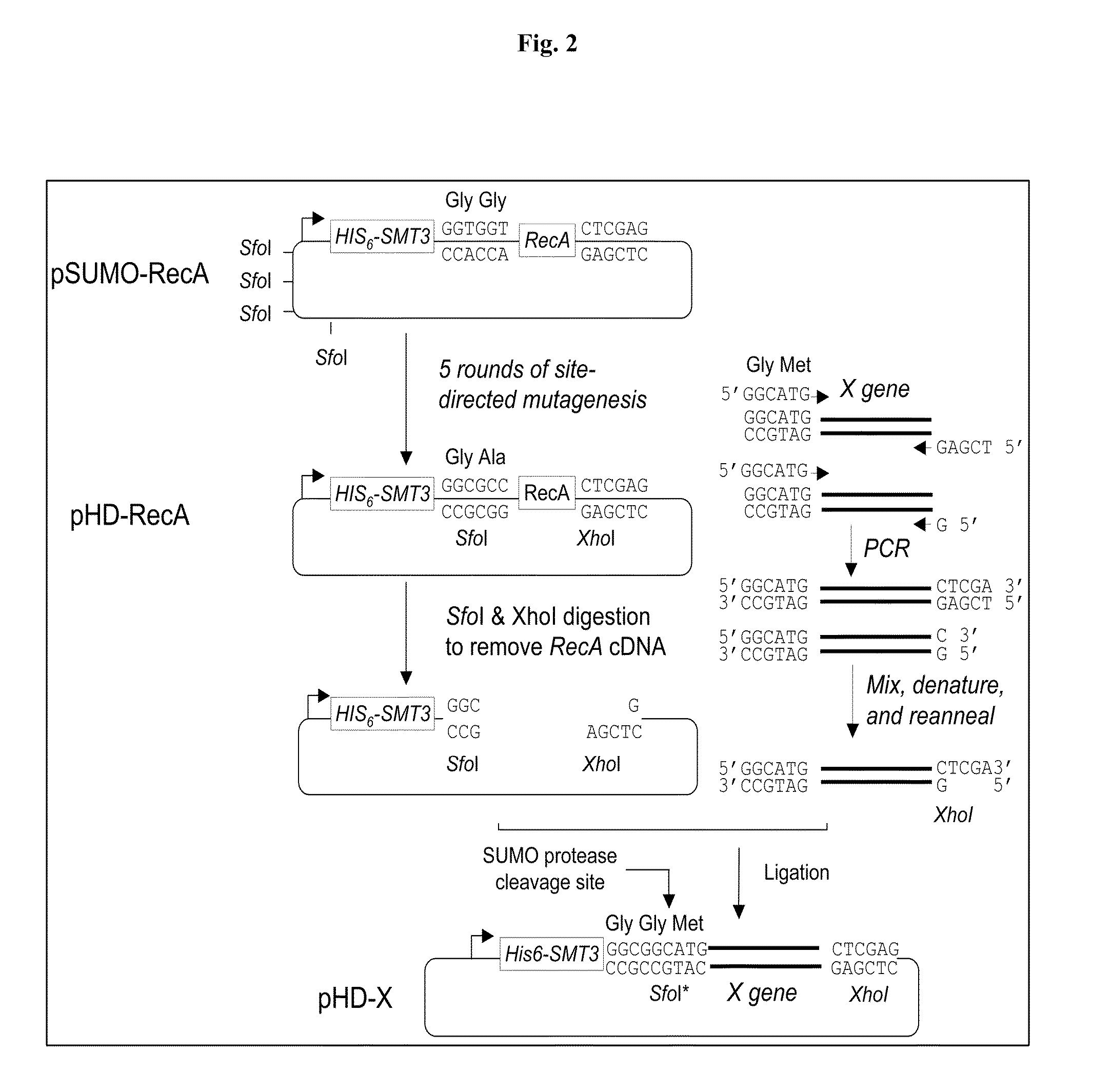SUMO fusion protein expression system for producing native proteins
a technology of fusion protein and expression system, applied in the direction of polypeptides with his-tags, peptide/protein ingredients, peptides, etc., can solve the problem of failure to recover active or structurally intact target proteins
- Summary
- Abstract
- Description
- Claims
- Application Information
AI Technical Summary
Benefits of technology
Problems solved by technology
Method used
Image
Examples
example 1
Production of Fusion Protein Containing Smt3 and Escherichia coli RecA Protein
[0023]The Saccharomyces cerevisiae Smt3 gene was cloned into pET32-Xa / LIC vector (Novagen, USA), downstream of the His6-tag contained in this vector to produce a His6-Smt3 expression vector.
[0024]The open reading frame of the Escherichia coli RecA protein was first cloned into the pET32-Xa / LIC vector (Novagen, USA) to generate a thioredoxin(Trx)-RecA expression construct. The DNA fragment encoding the Trx protein was then replaced by that of the His6-Smt3 protein. As a result, the open reading frame of the Escherichia coli RecA protein is downstream of and in-frame with the His6-Smt3 gene to produce a SUMO-RecA expression construct (pSUMO-RecA).
[0025]pSUMO-RecA as described above was transformed into JM109(DE3)-competent cells, which were cultured overnight at 37° C. in the presence of 100 mg / L ampicillin to produce an overnight culture (15 mL). The overnight culture was then transferred to 1 L fresh Luria...
example 2
Preparation of Free RecA protein from His6-Smt3-RecA Fusion Protein Via a One-Column Approach
[0027]Described below is a one-column approach to produce free RecA protein from the His6-Smt3-RecA fusion proteins produced by the method described in Example 1 by U1p1 cleavage.
[0028]U1p 1403-621, a fragment of Saccharomyces cerevisiae U1p1 protein (amino acid residues 403-621), has been shown to cleave a C-terminal tagged yeast Smt3 in vitro, producing its mature form (i.e., C-terminal “Gly-Gly). See Mossessova et al., Mol. Cell 5:865-876 (2000). The open reading frame of U1p1403-621 was cloned into the pET28a vector (Novagen, USA) to generate an expression vector, which was then transformed into E. coli cells to express a His6-U1p1403-621-His6 fusion protein. This recombinant enzyme, soluble in water, was purified from the crude extract of the transformed E. coli cells, using Ni2+ resins. The final yield was ˜20 mg / L Escherichia coli culture. The protein migrated as a single band on an S...
example 3
Construction of SUMO Fusion Protein Expression Vector pHD
[0035]pHD, a SUMO fusion protein expression vector, was constructed as illustrated in FIG. 2. First, the pSUMO-RecA vector described in Example 1 was subjected to five rounds of site-directed mutagenesis reactions to mutate the four Sfo I (5′GGCGCC3′) restriction sites in the backbone of pET32-Xa / LIC to either 5′GGCTCC3′ or 5′GGCACC3′, and to create a new Sfo I restriction site at the SUMO protease cleavage site by mutating “GGTGGT,” encoding the two C-terminal residues ‘GlyGly’ of Smt3 to “GGCGCC”, encoding ‘GlyAla’. Next, the mutated pSUMO-RecA vector thus produced was subjected to Sfo I and XhoI digestion to remove the DNA fragment encoding RecA, resulting in a linear vector pHD, one end of which is a Sfo I site and the other end of which is a XhoI site.
[0036]This linear vector can be inserted with any target gene prepared by the sticky-end PCR cloning method described in Shih et al. Protein Sci. 11:1714-1719 (2002) via the...
PUM
| Property | Measurement | Unit |
|---|---|---|
| pH | aaaaa | aaaaa |
| pH | aaaaa | aaaaa |
| molecular weight | aaaaa | aaaaa |
Abstract
Description
Claims
Application Information
 Login to View More
Login to View More - R&D
- Intellectual Property
- Life Sciences
- Materials
- Tech Scout
- Unparalleled Data Quality
- Higher Quality Content
- 60% Fewer Hallucinations
Browse by: Latest US Patents, China's latest patents, Technical Efficacy Thesaurus, Application Domain, Technology Topic, Popular Technical Reports.
© 2025 PatSnap. All rights reserved.Legal|Privacy policy|Modern Slavery Act Transparency Statement|Sitemap|About US| Contact US: help@patsnap.com



